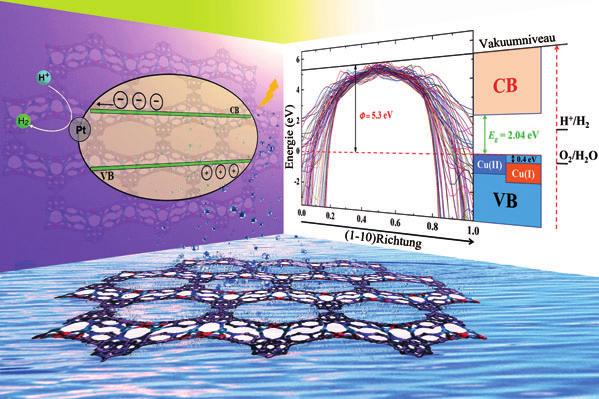First Efficient yet Economical 3D MOF with Doubly Photocatalytic Activities Developed by Bin Zhao’s Group
Under the joint efforts of Pro. Bin Zhao’s group and Pro. Weichao Wang’s, a novel photocatalyst with bifunctional photocatalytic activities in water splitting and photo-degradation of organic pollutants, was successfully synthesized and structurally characterized. The related work has been published on Angewandte Chemie early in January.
By far, it’s the first report on the photocatalyst that can not only produce hydrogen, a source of green energy, through photocatalytic splitting of water, but degrade organic pollutants. It possesses excellent solvent and thermal stability, and can be used three times with its high efficiency nearly unchanged, which make it a valuable assistant in the preparation of hydrogen and the decomposition of organic pollutants to tackle such problems as energy shortage and environmental pollution that people are increasingly concerned with.

MOF, namely metal-organic-framework, was first identified as a new class of material for photocatalytic hydrogen production. To date, some hydrogen production photocatalysts based on MOFs have been explored. However, most of the MOFs need additional photosensitizers to perform appropriately, and the metal ions used in constructing the MOFs are mainly expensive metals, for example, Ru, Pd, Ti, and Zr, which, on a certain degree, constrains their further use.
While the unique semi-conductive MOF reported here is capable of producing hydrogen and degrading organic pollutants without adding any photosensitizers. And the metal ion used to construct the MOF is copper ion, which is far more economical than those mentioned above.
According to single-crystal X-ray diffraction analyses, the MOF is a 3D twofold interpenetrated framework with mixed-valence dinuclear Cu subunits.
It has strong absorption in the visible light region with a narrow band gap of 2.1 eV, which indicates that the photocatalyst can be considered as an ideal semi-conductive MOFs material. Theoretical studies, based on the calculation of the work function of MOFs, exhibit a good band alignment with the water redox energy levels, which makes it an efficient catalyst in the photocatalytic hydrogen evolution reaction. It has also been demonstrated to display promising visible-light-driven catalytic activities through employing photo-generated electrons and holes.
Pro. Bin Zhao: BS, Sichuan Normal College, China (1998); PhD, Nankai University, China (2004) Research Interest:Lanthanide-Based Luminescent Materials; Molecule Magnetic Materials; Construction of Functional Metal-Organic Frameworks.
Related work has been published on Angewandte Chemie recently. Detailed information can be obtained by click the link: http://onlinelibrary.wiley.com/doi/10.1002/anie.201508325/full.

